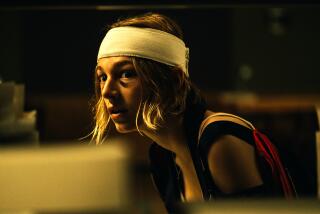His sound effects are loud and clear in âThe Hurt Lockerâ
As a native of the tiny Swedish town of LĂśnsboda, Paul N.J. Ottosson never expected to find himself in Jordan recording Muslim calls to prayer and car horns. But as sound supervisor, sound designer and re-recording mixer on director Kathryn Bigelowâs acclaimed Iraq war thriller âThe Hurt Locker,â due out this week on DVD, he did exactly that.
Sound editors collect or create all of the sounds heard in a film; sound mixers take every separate sonic element -- the dialogue, the effects and the score -- and then mix them together to craft what becomes a movieâs finished soundtrack.
FOR THE RECORD:
Working Hollywood: The Working Hollywood column in Sundayâs Calendar said that supervisor, sound designer and re-recording mixer Paul N.J. Ottosson went to Jordan to record sounds for the film âThe Hurt Locker.â Ray Beckett was the production sound mixer working on location in Jordan for the movie. â
Ottosson wore both hats on âThe Hurt Locker,â due to the productionâs limited budget. While itâs unusual to do double duty, he also edited and mixed 2007âs âThe Messengersâ in addition to working on dozens of other projects in various capacities. He received an Oscar nomination for sound editing for 2004âs âSpider-Man 2.â
He never intended to get into the movie business, however.
Always musically inclined, Ottosson played keyboard, flute, piano and bass guitar from a young age, and he originally headed to Hollywood with a Swedish band that he describes as âMĂśtley CrĂźe meets Whitesnake.â
But his rock star dreams underwent a slight modification when he was hired by Nickelodeon to work on âThe Secret World of Alex Mackâ in the 1990s.
âI think it was No. 1 for Nickelodeon at the time,â Ottosson said. âMy friend and I, we cut all the sound for it and mixed it. We had never done any of that, so we were just winging it. And the interest really started from that as I began to see the possibilities of what you can do with sounds.â
Since then, Ottosson also has seen the possibilities of what sounds can do for him.
âI donât think thereâs been a day in the last 10 years where Iâve thought, âAh, I wish I didnât have to work,â â he said. âI feel really fortunate doing what I do.â
Shock and awe: Ottosson spent a year and a half as a ranking officer in the Swedish military, and he drew on his personal experience when creating and recording sounds for âThe Hurt Locker,â about a U.S. Army bomb squad disposal unit.
âIâve exploded just about anything you can explode, and Iâve shot just about everything that can be shot,â he said. âI remember when we exploded our first bomb. We went into a bunker underground about maybe 50 yards away, and we triggered it and blew it up. And it wasnât so loud. But literally, the air in front of you trembled, and the shock wave hit your body, and everything inside your body shook. So thatâs what I try to convey in the first explosion [in the film].â
Sonic truth: Ottosson likes to use organic as opposed to synthesized sounds. âFor âThe Hurt Locker,â I recorded a lot of these sounds in the Middle East,â he said. âI also recorded guns out in the deserts here in California. Then we went to foley stages, and we recorded a lot of the gear of the movie, and I also got the bomb suit that they used in the movie. Thereâs an air conditioner in the bomb suit that the techs use. I got that down and all the sounds that it makes. And we also recorded a lot of stuff between takes. There were animals in the area and the winds and vehicles. So we tried to capture as much as we could -- city life, these calls to prayer that they have very often in the Middle East and the Muslim part of the world. Thereâs not a whole lot of stuff we tried to fake and get by the audience.â
Cue factor: Ottossonâs organic approach extended to the music in the film. âWhen the music came in, I was aware I was watching a movie,â he said. âSo when we mixed it, sometimes we would ease in on the start of the music, so you didnât feel when it started. Depending on what kind of general tone the music was in, I would try to create some sounds that would blend in with the music. So some natural sounds would become slightly unnatural over time and then mold into what would be the music. It would take the edge off of being aware of when the music cues started.â
Still life: âSilence is perhaps as important as a lot of sound because when you have quietness, you focus the audience,â Ottosson said. âThey become as quiet as the guys on the screen. You hear the bad guy breathing, the wind blowing outside. You can do more subtle changes, and they will be perceived by the audience.â
More to Read
The biggest entertainment stories
Get our big stories about Hollywood, film, television, music, arts, culture and more right in your inbox as soon as they publish.
You may occasionally receive promotional content from the Los Angeles Times.










